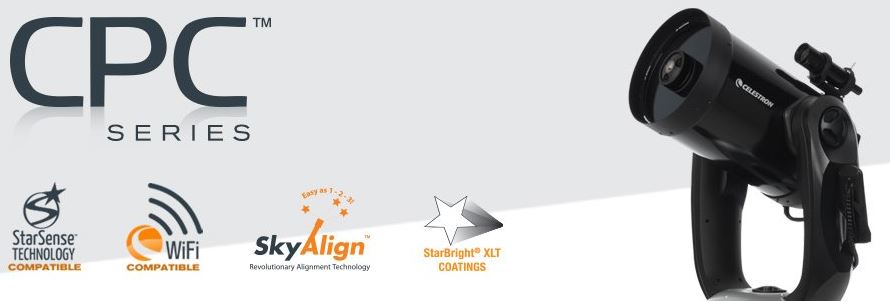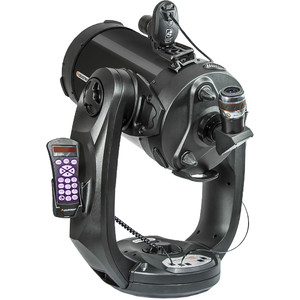Product series:

The CPC series offers Schmidt-Cassegrain optics on a solid two-arm fork. The CPC telescopes impress thanks to their large ball bearings, high running precision and very good vibration characteristics. Even at high magnifications, very precise tracking is guaranteed.
The telescope has a GPS receiver and a GoTo computer control that can be used to automatically locate up to 40,000 objects. Despite these features, the telescopes are easy to transport.

Celestron
Schmidt-Cassegrain telescope SC 203/2032 CPC 800 GoTo
$ 3,390.00
Sale price:
$ 2,836.03

Celestron
Schmidt-Cassegrain telescope SC 235/2350 CPC 925 GoTo
RRP:
$ 4,530.00
Our price:
$ 4,480.00

Celestron
Schmidt-Cassegrain telescope SC 203/2032 CPC 800 GoTo StarSense AutoAlign
RRP:
$ 4,220.00
Our price:
$ 4,010.00
Celestron CPC

StarBright XLT

A very important factor in evaluating the performance of telescopes is transmission, that is the proportion of incident light that arrives at the image plane.
The main characteristics of the StarBright®-XLT coating are as follows:
- Highly reflective multi-layer mirror coating: the mirror coatings consist of precisely applied layers of aluminium, quartz, titanium dioxide and more quartz. The reflectivity is constant across the spectrum, and the three layers of coating provide excellent protection against the ageing of the mirror surface.
- Corrector plate: crystal-clear glass instead of soda lime glass is used for the corrector plate in all Celestron Schmidt-Cassegrain optics with StarBright-XLT coating. Uncoated, this glass delivers approximately 90.5% transmission. Together with the StarBright®-XLT coating, its transmission reaches 97.4%!
The entire optical system consisting the corrector plate, mirror and lenses achieve a transmission maximum of 89% at 520 nanometres (where the dark-adjusted human eye has its highest light sensitivity). The average transmission over the entire visual spectrum from 400 to 750 nanometres is 83.5%.
SkyAlign

Simply enter the date, time and location into the hand-held controller (GPS models determine this information automatically), and point at three bright stars of your choice. You don’t even need to know the names of the stars, and you can even choose bright planets or the Moon. The NexStar computer system identifies these stars and correctly aligns the telescope.
The NexStar controller also allows other alignment procedures, such as using just one star - however you need to know its name - or a single planet.
All these procedures are not only very easy for a beginner to master, they also allow the control to be set-up at dusk, when even experienced astronomers may not be able to name the first stars with confidence.
PWI Telescope Control Software

The software was developed together with PlaneWave Instruments and enables a highly accurate GoTo control. The PointXP Mount Modelling, which is also used in the Celestron StarSense module, is used for this purpose, and allows a much more accurate model of the sky than the electronics of a hand control box. Various reference stars are used to compensate for numerous types of alignment errors, including telescope flexing.
Besides the higher accuracy, control via a PC/laptop combined with the stored star chart is particularly simple and intuitive. In addition, the PWI software has a larger object database than the manual control. If you have Internet access, PWI can even access the SIMBAD professional astronomical database.
The PC/laptop is connected via USB 2.0. The PWI software runs on Windows 7, 8, and 10.
